In 2005, the PBS broadcaster and journalist Patt Morrison penned a perfectly sound argument titled “Kill Barbie” for the Los Angeles Times.
The writer, who used the iconic doll as a sword during childhood duels, noted that: “The nail in Barbie’s grotesquely proportioned coffin is last winter’s study by a British university about how ferociously little girls mutilate their Barbies, just for fun. They scalp them and dismember them and burn them and microwave them. Frankly, Barbie had it coming. She’s just too unreal. How do you bond with something that looks like a taffy pull with a face?”
The nail in Barbie’s curvaceous coffin has been greatly exaggerated, but the early years of this century were a tumultuous time for Mattel’s most famous creation.
In 1997, Share-a-Smile Becky, one of Barbie’s friends with a wheelchair, sold 6,000 units within days of release, only for children to discover that the wheelchair couldn’t fit through the doors of Barbie’s Dream House. The wheels didn’t even move. It was an own-goal to rank alongside the pronouncements of 1968′s Talking Barbie: “Math class is hard,” “I can’t wait to plan my wedding”, and “Will we ever have enough clothes?”
Innumerable 21st-century studies, including “2004′s The effect of experimental exposure to images of dolls on the body image of 5- to 8-year-old girls” and “2014′s Exposure to Barbie: Effects on thin-ideal internalisation, body esteem, and body dissatisfaction among young girls” paint a damning picture of Barbie’s malignant influence on body image
In 2008, the Guardian asked its readers: Is Barbie a feminist icon, or would it be better for women if she was wiped off the face of the earth? Seventy-one per cent of voters plumped for the latter obliterating option.
Barbie was losing her public.
Writing in Feminist Media Studies in 2017, Karen Orr Vered and Christèle Maizonniaux noted Barbie’s often desperate efforts to reinvent herself as a 21st-century gir boss in the insalubrious straight-to-DVD market. Beginning in 2001, a series of CG animated narratives – from Barbie in The Nutcracker to Barbie and The Three Musketeers – “reflects an awareness of feminist criticism and seeks to remediate Barbie’s particular femininity and the associated gender performance that has fallen into disfavour.”
It’s complicated.
As Marlys Pearson and Paul R Mullins point out in their 1999 paper, Domesticating Barbie, Barbie is all things to all women: “a ditsy hedonistic consumer, a hypersexualized bimbo, a subjugated homebody, [and] an utterly independent woman, who demonstrates that girls can do anything.”
“Anything” isn’t always positive.
Barbie’s creator, Ruth Handler, always insisted that through Barbie, “a girl could be anything she wanted to be.” Barbie’s 200-plus jobs – including presidential candidate, surgeon, McDonald’s cashier, and 1992′s unfortunate Rappin’ Barbie – make for a spectrum that runs from the aspirational to the downtrodden.
In 1965, four years ahead of the moon landing, Mattel launched Miss Astronaut Barbie; in the same year, Barbie’s Slumber Party play set hit shelves, featuring pink bathroom scales permanently set to 50kg, and a How To Lose Weight manual contained just two words: “Don’t eat.”
My 29-year-old son wears pink. I have a 74-year-old friend who was wearing pink recently and said it was Barbiecore
Contemporaneous feminists were – and continue to be – concerned about Barbie, as a harbinger of thigh gaps and patriarchal constraint.
In 1970, two years after Mattel introduced Christie, Barbie’s fashionable black friend, the rallying cry for the Women’s Strike for Equality in New York City was: “I am not a Barbie doll!”
Speaking in the 2018 documentary Tiny Shoulders, Gloria Steinem said, “I am so grateful I didn’t grow up with Barbie. Barbie is everything we didn’t want to be, and were told to be.”
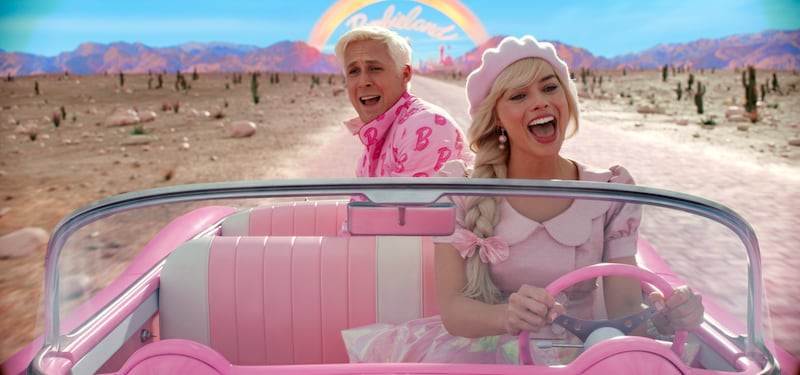
“The idea that you’re strengthening your daughter by saying, ‘You can be anything’, really ends up making her feel guilty if she can’t,” added the second-wave feminist. “So, maybe a Bipolar Apocalypse Barbie, programmed with phrases like, ‘Glass ceiling!’ and ‘Rape culture!’ and, of course, ‘I’m going to go put my head in my Official Accessory Barbie Gas Oven!’ ”
Something has shifted in the five years since Steinem called for Bipolar Apocalypse Barbie.
In one of the movieverse’s most intriguing tentpole showdowns, Greta Gerwig’s Barbie movie is currently tracking for an $80 million opening, Christopher Nolan’s rival Oppenheimer, which is also released worldwide on July 21st, is expected to play second fiddle with a $40 million gross.
That’s quite a leap from the home video exclusivity of 2002′s Barbie as Rapunzel.
“I think the MeToo movement has a lot to do with it,” says disability activist, Alannah O’Neill Murray of the femme feminism that has allowed for Barbie’s rehabilitation. “MeToo was a way to talk about the people who were most impacted by oppression in the film industry, whether that oppression was against disabled people, or women, or trans people. It created an awareness of grievous behaviour and errors and a way to call that out. People call that cancel culture but at the end of the day, you have nothing to worry about if you’ve done nothing wrong.”
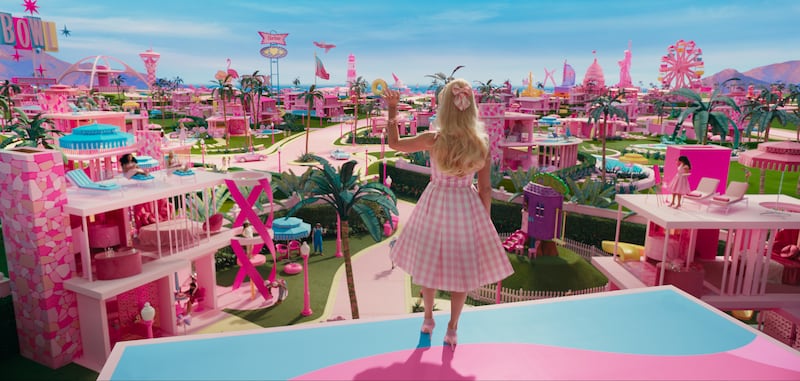
Even before the first image from writer-director Greta Gerwig’s incoming Barbie movie emerged, Barbiecore, the very pink, very Barbie-inspired fashion trend, had completely captured the zeitgeist.
“Pink is a lot more egalitarian now,” says Sarah Greenwood, the production designer on Barbie. “My 29-year-old son wears pink. I have a 74-year-old friend who was wearing pink recently and said it was Barbiecore. It’s all about embracing a side that’s softer and fun. That can only be a good thing.”
Pink is having a moment; a long moment.
Last year’s 2022 Valentino Fall runway show debuted Valentino Pink PP – named after the fashion house’s creative director, Pierpaolo Piccioli – a pigment that has been subsequently embraced by everyone from Saweetie to Khloe Kardashian. Sebastian Stan and Glenn Close went full Barbiecore at the 2022 Met Gala; Lizzo and Harry Styles rocked the look for a duet of Gloria Gaynor’s I Will Survive at last year’s Coachella.
“We’re moving away from a period when we had an oversaturation of what’s called millennial pink, a colour that came from mood boards and Pinterest,” says fashion data SME, Aimée O’Beirne. “We work with a fashion forecasting company called WGSN, and they have their finger in the air for incoming trends. The second-generation Valentino Pantine PP is very significant. Valentino has always been famous for their reds. The new pink also ties into a huge misconception about modern feminism and that old idea that you can’t be a feminist and wear make-up or pink, or be blonde or feminine. I think that feminine power is important for modern feminists. So Barbiecore is a little bit shocking and disruptive. It’s punk.”
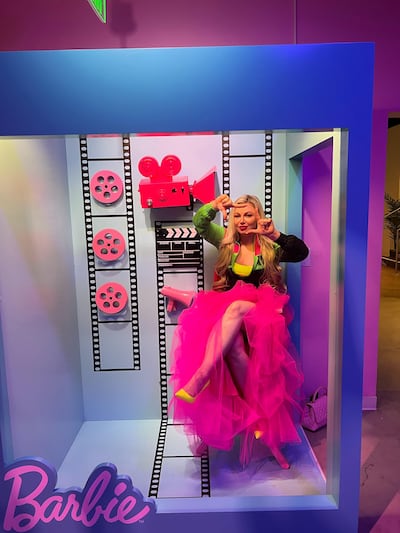
In that spirit, last July, Florence Pugh pushed Barbiecore to the maximum with a sheer, nipple-prominent, fuchsia gown, at a haute couture show in Rome. At the time of writing, the Barbiecore hashtag has amassed some 451.9M views on TikTok. “Barbiecore weddings are having a moment,” insisted Brides magazine last month. Lyst named Barbiecore the trend of 2022, recording that online searches for all things pink rocketed 416 per cent last year.
“For me, Barbie is pure joy and happiness, and reminds me of that magical time when as a kid all your wildest dreams could come true,” says film-makers Jessica Cameron, a Perma-Barbiecore advocate. “Barbie is and was anything and everything you wanted her to be: she could be an astronaut, a lifeguard, and a teacher all in one day. I loved that she dressed not based on what society told her, but on what was fun. She had no limits she couldn’t reach, no ladder in the workplace she couldn’t climb, and enjoyed every moment of her very productive and fulfilling life. Barbiecore is a way to connect to all of the above, and fun fashion in the purest sense of the term.
“Wild prints, bows and sparkles, essentially anything fun goes. An 80′s athletic neon windbreaker with a giant neon pink tulle skirt and 4″ neon green stilettos makes perfect sense in Barbie’s world because it’s fun and vibrant even though one could ponder: but where is she going in such an outfit? It doesn’t matter, she’s Barbie and she’s having so much fun.”
In stark contrast to the frontline of the 1970 Women’s Strike for Equality, being a Barbie is no longer a pejorative in a world where human Barbies and Kens – notably internet sensations Valeria Lukyanova and Jessica Alves – thrive.
Rehabs, an American mental health platform analysed Barbie’s anatomy in 2014, suggesting that If Barbie was a real woman she’d be forced to walk on all fours and that her waist could only accommodate “half a liver and a few inches of intestine”.
There’s no slyness in this film. It’s saying a huge amount but in a charming and gentle way. There are no baddies. Just a lot of pinks
— Sarah Greenwood, production designer
“Depending on the squint of the eye and the hand on the calipers, if Barbie was scaled-up to human size, she would stand 5 foot 6 inches tall, weigh 110 pounds, and have a 39-inch bust, 18-inch waist, and 33-inch hips,” says Dr A. Jamie Saris, an Associate Professor in the Department of Anthropology at Maynooth University. “On the one hand, such measurements are impossible to find “in nature”, an observation that, from the 1960s on, launched thousands of feminist critiques. On the other hand, plastic is also power. The first use of silicone implants for breast enhancement, for example, was in 1964, only a few years after Barbie’s birth, marking a decisive shift from a reconstructive surgery invented initially to repair deficits to a modern plastic surgery aimed at enhancing beauty. Later waves of feminism have developed a more nuanced relationship between such enhancement and ideas of empowerment, particularly in an era where influencers” in digital media can exert enormous outsized effects on the culture.”
The voguish rise of Barbiecore and all things Barbie chimes with sentiments expressed by Diablo Cody in the current issue of GQ Magazine. In a candid interview, the Oscar-winning writer of Juno recounts her failed 2015 attempt to write a Barbie script for the comedian Amy Schumer.
“I think I know why I shit the bed,” she said. “When I was first hired for this, I don’t think the culture had ... embraced the femme or the bimbo as valid feminist archetypes yet. If you look up Barbie on TikTok, you’ll find this wonderful subculture that celebrates the feminine, but in 2014, taking this skinny blonde white doll and making her into a heroine was a tall order.”

Enter Greta Gerwig, the Oscar-nominated writer-director of Lady Bird and Little Women. Working from a screenplay she co-wrote with partner Noah Baumbach, Gerwig’s Barbie follows the titular doll (Margot Robbie, who also produced) as she is exiled from Barbie Land for such abnormalities as flat feet, cold showers, burned breakfasts, and thoughts of mortality.
She and Ken (Ryan Gosling) journey in a series of pink vehicles to the real world in search of her little girl owner – the daughter of Mattel employee Gloria (America Ferrera) – so that Barbie might return to her old self and to Barbie Land, where every day is “the best day ever”.
[ Everyone needs to calm down about Barbie. Including meOpens in new window ]
Gerwig’s vision was guided by an early meeting with Mattel during which she was informed, “We don’t have different characters; all of these women are Barbie.” By Gerwig’s reckoning, that meant “all of the women were Barbie, and Barbie was all of these women.” Mattel concurred.
Thus, Hari Nef, Alexandra Shipp, Emma Mackey, Sharon Rooney, Dua Lipa, Nicola Coughlan, Ana Cruz Kayne, and Ritu Arya simultaneously play the doll. Gerwig’s various Barbie girls find their Barbie world courtesy of the fantastic plastic ideas of production designer Sarah Greenwood and set designer Katie Spencer.
Neither of the Barbie Land creators, who previously collaborated on Disney’s Beauty and the Beast, had ever owned or played with a Barbie before costume designer Jacqueline Duran gave them a head’s up to expect a sprawling, “massively long, unformatted script” from Greta Gerwig.
“Unboxing is a lovely word,” says Greenwood. “We had to literally and metaphorically unbox Barbie. So we didn’t come in with any baggage like, oh, you’ve got to be like this Barbie that I had as a child. We got our first Dream House in this film. It was a voyage of discovery and scale. Even though we didn’t replicate the house that Mattel made, it informed so much of what we did.”
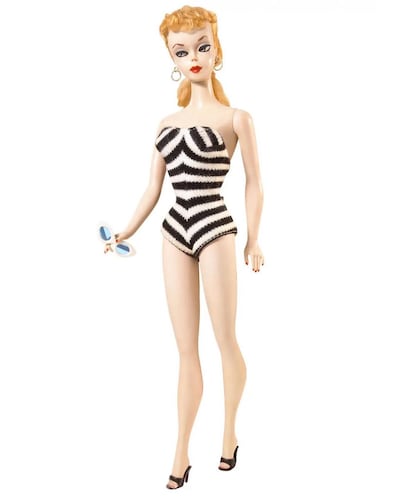
Gerwig compares Greenwood and Spencer’s Barbie Land to the Garden of Eden, a place where there “are no walls, and ... no embarrassment”. The designers consequently studied such paradisiacal Palm Springs midcentury architecture as Richard Neutra’s 1946 Kaufmann House and the Marxist-inspired Parisian landmark, Maison de Verre.
“Designing without walls was tricky from a design point of view,” says Spencer. “Because you have no back, you’re designing against the sky and trees. That was another complication that we became more aware of as time went on. For things like furniture, it meant they had to be very strong and simple. The absence of things can be important. The Pinterest pause!”
[ Six decades of Barbie’s Dreamhouses: From cardboard fantasy to TikTok-ready towerOpens in new window ]
Barbie was officially introduced in a chevron stripe black and white bathing suit in 1959, an outfit referenced by Margot Robbie during the press tour. Fifties Barbie was modelled on saucy German predecessor, Bild Lilli, “a gold-digger, exhibitionist, and floozy”.
Inspired by Reinhard Beuthien’s comic strip for the tabloid newspaper Bild, Lille was popular enough to get her own live-action comedy, Lilli – ein Mädchen aus der Großstadt, in 1958, starring Danish actress Ann Smyrner after a highly-publicised international casting call.
Interestingly, neither Lille nor the very single, very professional Barbie fashion doll of the 1950s would have been caught dead in pink. It wasn’t until the 1970s, when Mattel sought to market the doll to a younger audience that Barbie became synonymous with her signature colour, specifically Pantone Pink 219C, a hue that is copyrighted and owned by Mattel.
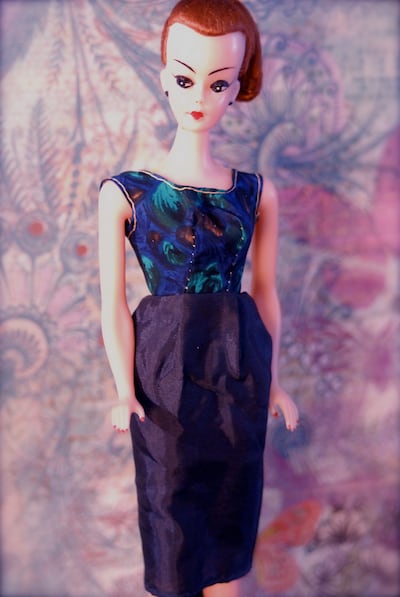
That shade and the entire pink spectrum proved a challenge for the production team, not least because the designers used so much fluorescent fuchsia paint that it created a global shortage. The team ultimately had to narrow the pinks down to ten shades while cinematographer Rodrigo Prieto had to build a rig to stop the colour bathing every shot.
“It’s a palette we’ve never worked with before,” says Greenwood. “This was our pink boot camp. It looks so simple now and I think about that because to arrive at that simplicity and that interpretation was a large journey. But working with Greta was fantastic. She’s an intellectual. Visually she knows what’s right when she sees it. And she really does love Barbie. There’s no slyness in this film. It’s saying a huge amount but in a charming and gentle way. There are no baddies. Just a lot of pinks.”
In certain respects, Margot Robbie’s journey to the real world in Barbie mirrors Barbie’s own innovations. As Alannah O’Neill Murray notes, Mattel took the pushback on Share-a-Smile Becky seriously and began listening to advocates. Last year, the toy company introduced a doll with a prosthetic leg, a doll with vitiligo, and a doll with behind-the-ear hearing aids “to increase representation and inclusivity”.
Last April, the new models were joined by the first-ever Barbie with Down syndrome. The current Barbie Dream House comes with a wheelchair-accessible elevator and ramp. And the Barbie Winter Sports Para Alpine Skier has already won the Olympics.
The medal is included in the box.
Barbie opens July 21st




















